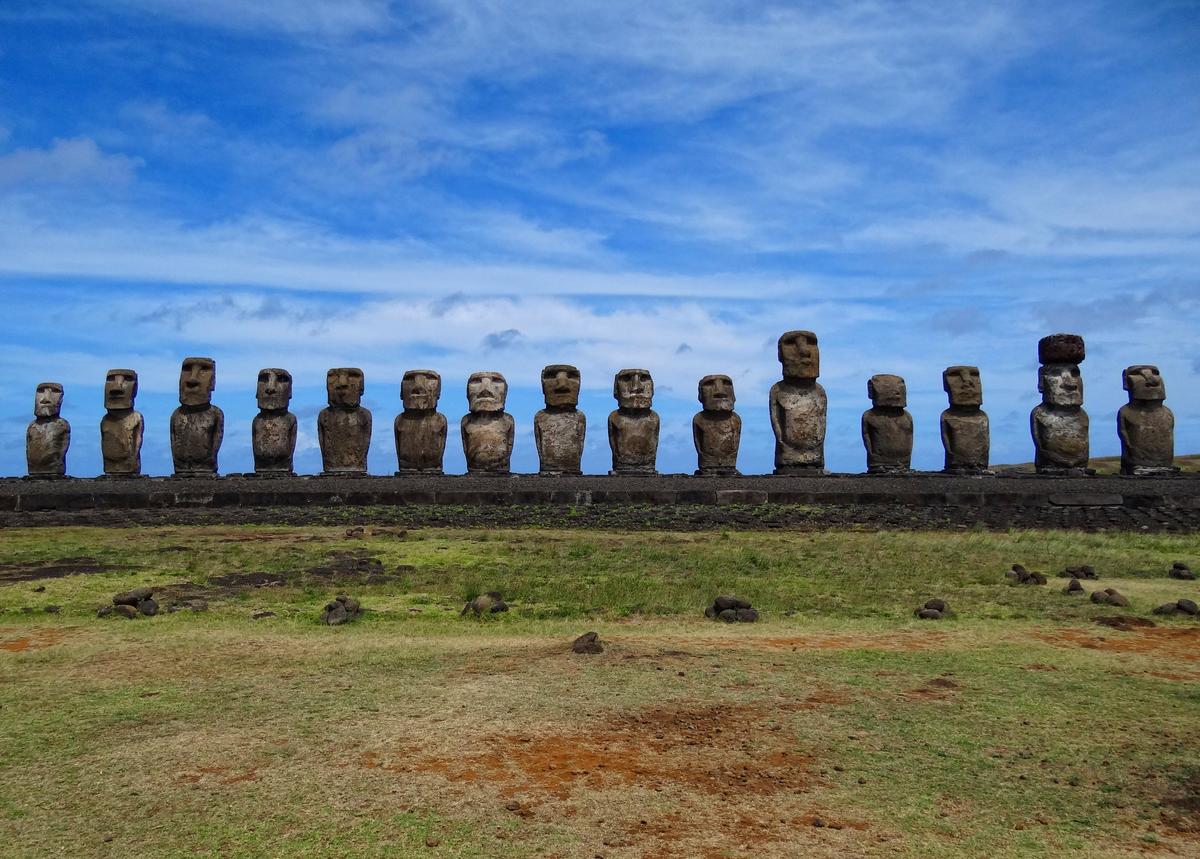The volcanic island of Rapa Nui has long been shrouded in mystery. European sailors first arrived on its shores on Easter Sunday in 1722, giving it its colloquial name: Easter Island. It covers just 160 sq. km and is one of the most remote islands on the planet. Today, Rapa Nui is part of Polynesia and is officially a territory of Chile.
Early Polynesian explorers are believed to have traversed thousands of kilometres of open ocean to reach and settle the island, likely arriving centuries before the Europeans. The island’s geography is harsh and challenging for humans. Its lava-covered terrain is rocky with limited freshwater sources, poor soil quality, and a low diversity of flora and fauna.
Despite these challenges, its first humans likely established a unique society in order to survive their exacting environs. However, the island’s offerings would still have been quite finite and ingenuity could only have taken the people so far. These realities gave rise to a widely held notion that the humans eventually overpopulated the island, resulting in ecological collapse and its people’s demise.
But new evidence suggests this view may be fiction.
Turning the gaze within
Rapa Nui is famous for its large statues called moai. They are shaped like large human heads and erected on stone pedestals. Some moaistand 40 ft tall and weigh 75 tonnes. They were carved in volcanic stone at quarries and then moved to their current locations across the island. Scholars believe the Rapa Nui built the moai between the 13th and the 16th centuries and represented their revered ancestors.
The statues all face inland, towards the people. Over 900 moaihave been found on the island to date; more than half of them were transported across considerable distances from the quarries.
In his book 2004 Collapse, Jared Diamond proposed the population of Rapa Nui collapsed after overexploiting resources. The idea quickly found wide acceptance and became an example of the importance of sustainable living. But some scholars have called into question the feeble evidence to support the hypothesis.
The Ahu Tongariki stone platform on Rapa Nui with all its 15 moai, restored in the 1990s.
| Photo Credit:
Bjørn Christian Tørrissen (CC BY-SA 3.0)
Protecting the soil
Scientists think the island’s population had declined by around 1600, before European explorers arrived in the 18th century. By then the population was estimated to be around 1,500-3,000.
Due to the limited availability of freshwater and the abundance of rocks, which limited widespread agriculture, the natives are believed to have burnt the palm vegetation to improve soil productivity.
They were also expected to have used rock gardening, a.k.a. lithic mulching: a way to protect soil moisture by regulating the temperature.
Either way, before the European settlers made contact with the Rapa Nui, the latter practised a limited agriculture to produce their food.
A long-awaited census
In July, researchers from Columbia University, Arizona University, and Binghamton University, plus independent researchers from Rapa Nui, reported training an AI model to identify locations in satellite images of the island where its inhabitants practised rock-gardening.
The researchers estimated rock gardening was practised in less than 1 sq. km of the land, lower than previous estimates of 4-20 sq. km. Assuming the inhabitants exclusively cultivated sweet potatoes, the findings suggest they may have numbered fewer than 4,000 people.
Genetic studies have in the past have provided unique insights into the histories of Indigenous and ancestral populations around the world. In 2014, Current Biology journal published a paper in which researchers analysed 27 genomes of the Rapa Nui people and concluded they had a considerable Native American ancestry, of around 8%. They also found the admixture with Native Americans happened before the 18th century. A significant European admixture followed when Europeans discovered and then colonised the island in the 18th century.
Two catastrophes
In the event of an ecological collapse or a population bottleneck (when the genetic diversity of the population becomes so low as to become unable to withstand shocks like new diseases or disasters), the genomes would have been quite un-diverse in the population’s descendants. Such ‘signals’ could in turn provide insights into bottlenecks in the history of that population.
Members of the Rapa Nui community resisted an initial attempt by researchers to study their genomes. So a team led by Víctor Moreno-Mayar at the University of Copenhagen turned to the remains of 15 Rapa Nui people secured at a museum in Paris. The remains were dated to have originated between 1670 and 1950 AD. The team extracted and sequenced DNA from tissue samples, and reported their findings on September 11 in Nature.
According to the study, the Rapa Nui population developed a bottleneck around 1300 AD — confirming a previous finding that highlighted the same date and, crucially, ruling out a population decline in around 1600 AD. Instead, the study suggested the population steadily grew until the European settlers arrived, followed by two catastrophic events: Chilean slave traders abducted more than a third of the population and then there was a large outbreak of smallpox. The local population soon dwindled to a hundred or so individuals as a result.
Restoring real histories
So there we have it: the pre-modern Rapa Nui didn’t overexploit the resources of their small island. In fact, they may have been living responsibly, only to be decimated by the apathy of other peoples.
Studying indigenous genomes offers invaluable insights into historical population dynamics, ecological adaptations, and the complex stories of human migration and survival. In many ways, the Rapa Nui genomes also show how genomic evidence can expose the derogatory myths that often surround Indigenous people and give them their real histories back.
The authors are senior consultants at Karkinos Healthcare and adjunct professors at IIT Kanpur and the D.Y. Patil Medical College, Pune.
Published – September 18, 2024 05:30 am IST












